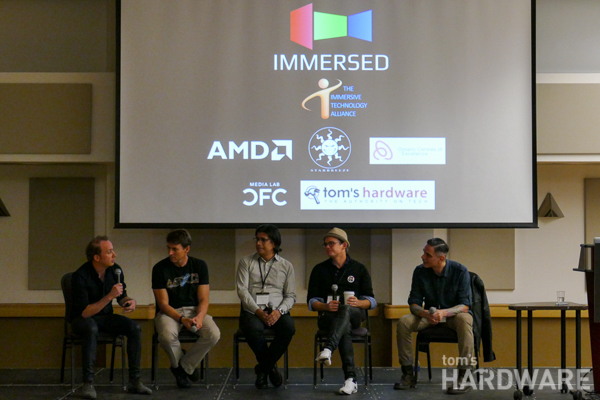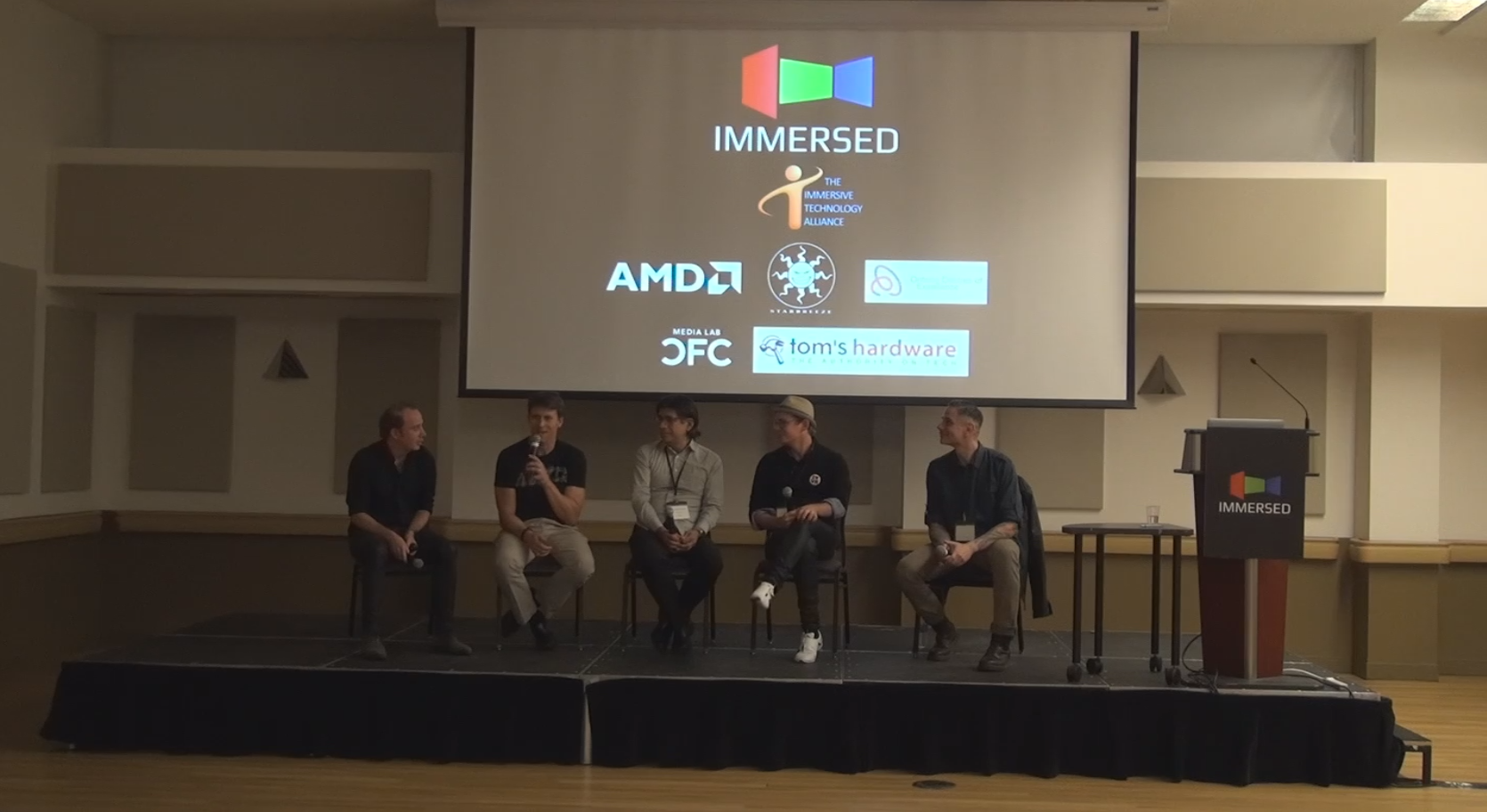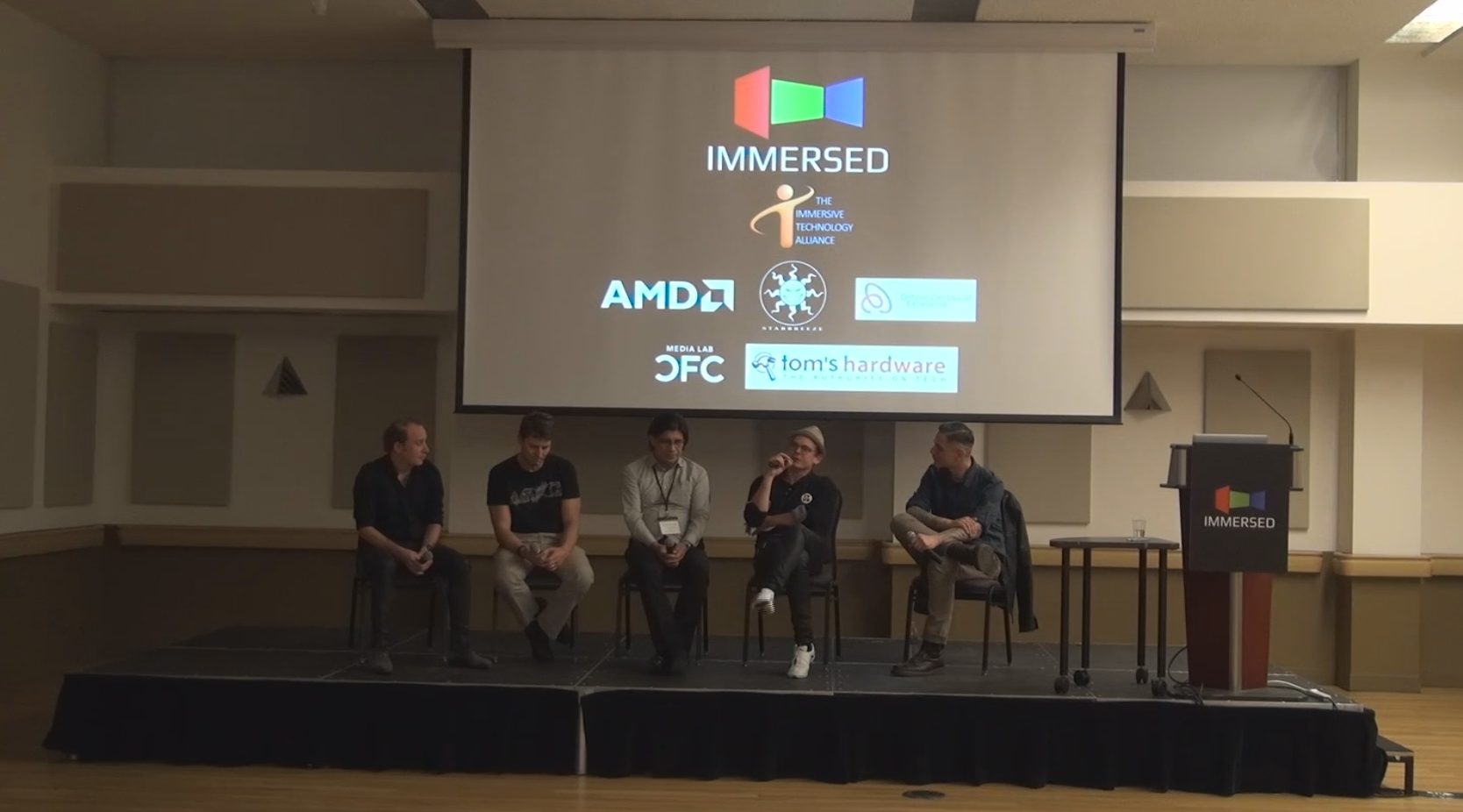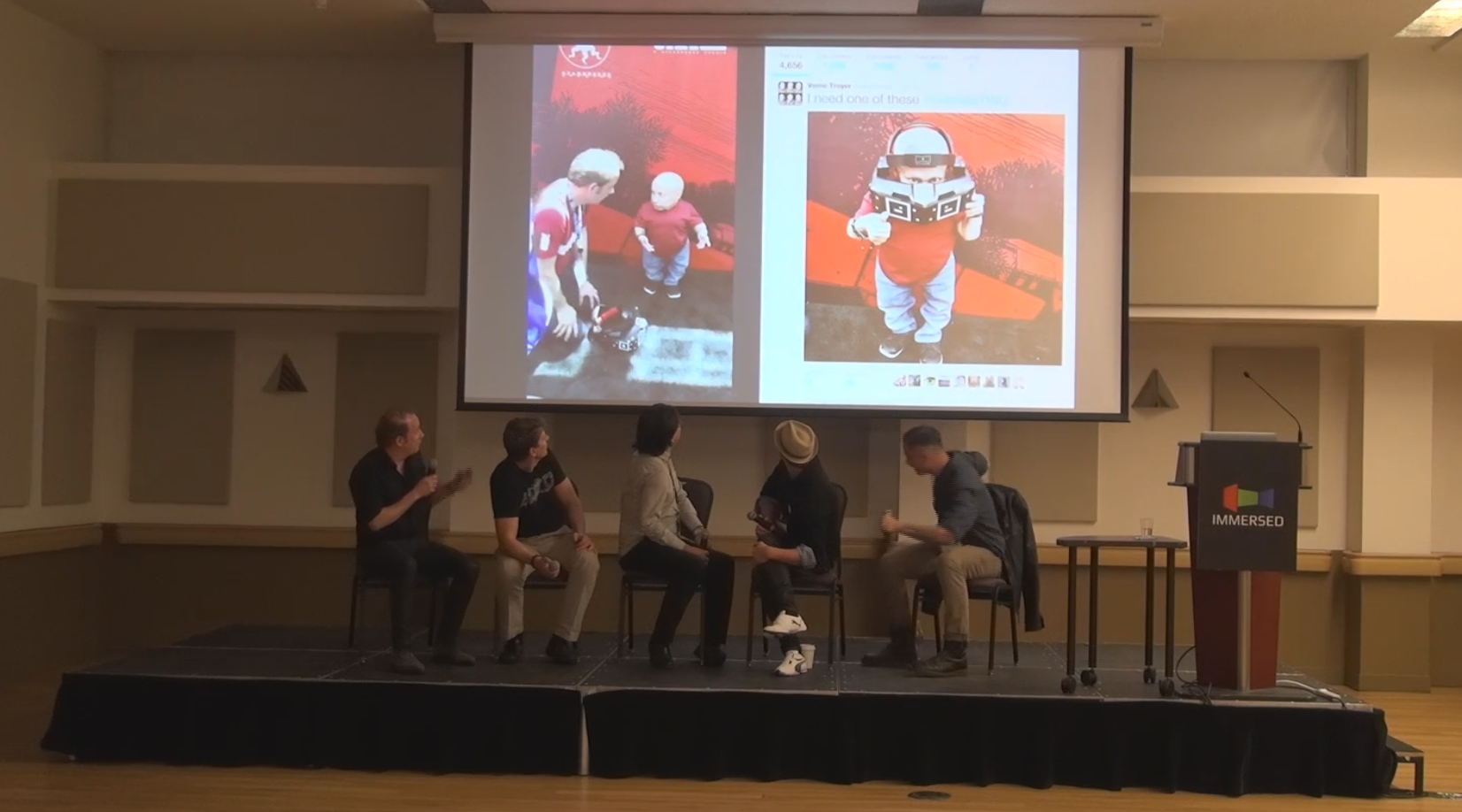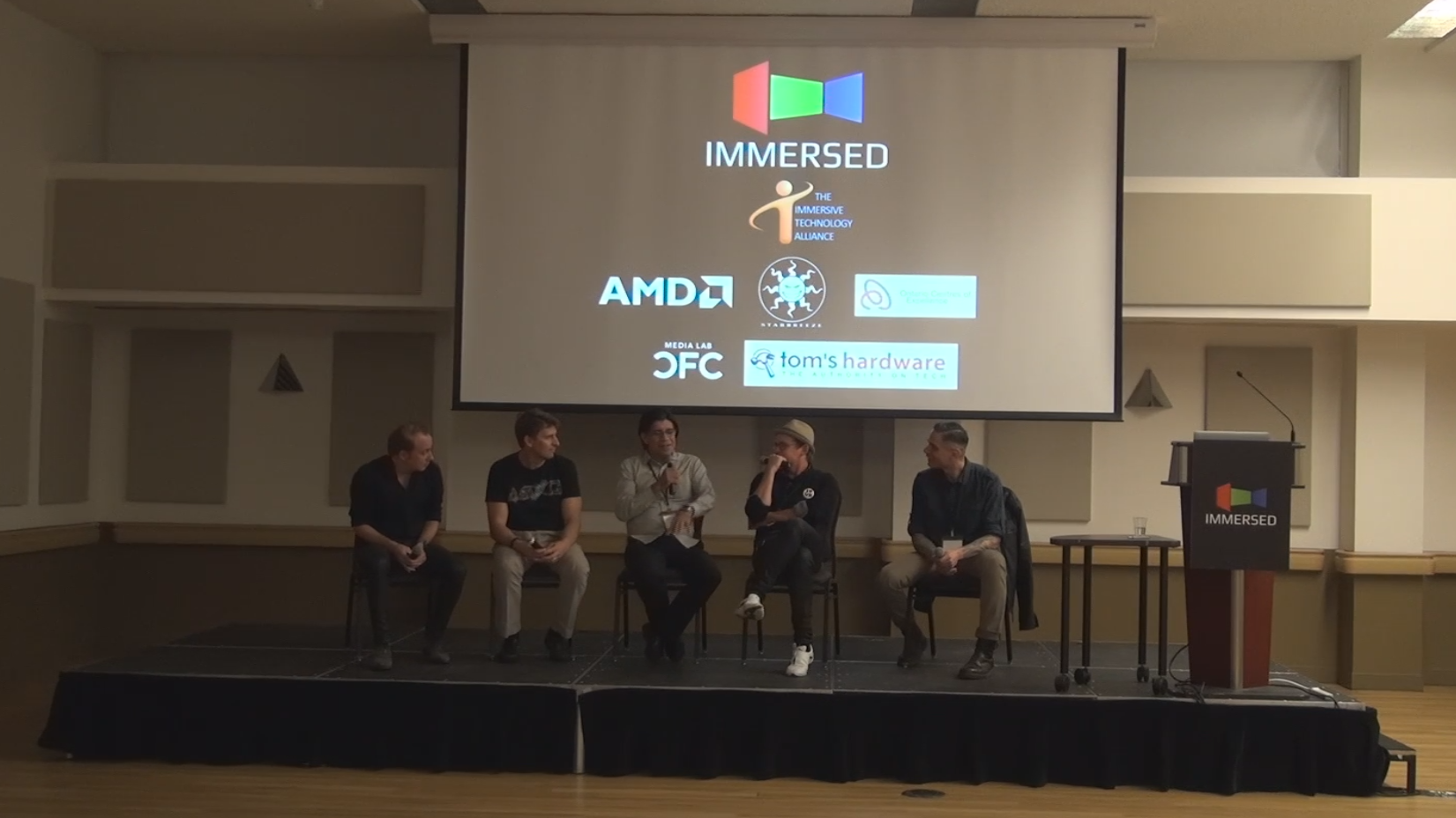'VR Literacy,' Doing Good In VR, And More: Immersive Gaming Panel At Immersed 2015
During the third day of the Immersed 2015 conference in Toronto, Ontario, a panel discussion about immersive gaming took place. The discussion was moderated by Lucas Cochrane of Daily Planet on Discovery Channel Canada, and four industry insiders spoke about their experience creating VR content, where the technology is heading, and how far it is from certain milestones, such as untethered experiences.
Joining Lucas Cochrane on stage was Dario Laverde, Senior Developer Evangelist at HTC; Ben Miller, Director of Content Development at WEVR (creators of the Vive experience called theBlu); Guillaume Gouraud, SVP Business Development StarVR project at Starbreeze Studios,; and Dr. Richard Marks, Director of PlayStation Magic Lab at Sony Computer Entertainment.
Motion Sickness
After a brief introduction of each panelist, Lucas kicked off the questions by asking what is being done to tackle motion sickness. Ben Miller was the first to respond, stating that we're at the stage where it's not a hardware issue anymore, but rather a software issue. Frame rate targets are key. He said it's a total non-starter if your game is dipping below the desired frame rate.
Dario Laverde agreed with this statement, adding that 90 fps should be the minimum target. This frame rate tends to mitigate motion sickness issues, but less than 90 fps can be unpleasant.
Dr. Richard Marks believes that positional tracking is the key to making it work. VR without head tracking is not something you want to do, but having your head tracked naturally goes a long way to avoid VR sickness issues.
Guillaume Gouraud feels like resolution has more to do with it. He said that with the current panels, objects can often appear blurry, which makes it hard to focus. Higher resolution panels in the future will limit motion sickness by improving clarity.
You Need To Be Grounded To Reality
Lucas then brought up his experience trying The Walking Dead on StarVR the day before. He said that he started to get a bit queasy when he was being wheeled down the hallway, but that he recovered quickly. Guillaume said that matching the real environment to the virtual one goes a long way in countering this feeling. The physical chair gives you a connection to the real world, which makes it feel real. For this reason, Starbreeze provides a real wheelchair for the seated demonstration.
Get Tom's Hardware's best news and in-depth reviews, straight to your inbox.
Richard added that having hands tracked in virtual space helps to ground users to the real world, as well. Ben then chimed in, saying that in his experience, vertical motion is far less nauseating than a forward or turning motion, but he mirrored the statement that the experience must match the physical world. Playing a seated experience, such as The Getaway, while standing, would likely not be a good experience.
Richard said that he hadn't actually tried that, but did note that another game demo they have, a street luge game, is much more compelling when laying down, as it brings you further into the experience. He talked about the How To Train Your Dragon experience that Dreamworks made, where you ride a dragon in VR. Raising your feet off the ground made it a much more believable experience.
Ben then mentioned that this was one of his favorite experiences in virtual reality, and that Dreamworks ended up making stirrups to keep your feet in, which made it even more comfortable to experience. Everyone agreed that matching the physical to the digital world is key in combating the disconnection that occurs in virtual spaces, which can be unsettling for many people.
Multiplayer And Social Gaming
Lucas then steered the conversation towards social and multiplayer aspects of virtual reality. He wanted to know how far we are from "The Grid." He wants to know when he can be driving along in a vehicle like in The Getaway, but the driver is actually a friend in a VR helmet, and not an NPC in the game.
Ben believes that we'll be talking about social aspects of VR in the first half of next year, but that would be more likely over the Internet. He's not as convinced about situations where multiple people are in the same room with VR HMDs on. Dario brought up AltspaceVR and briefly talked about virtual chat rooms happening already on that platform. More social experiences will come out in the coming year, as well.
Richard brought up some of the games that are already coming, such as Eve: Valkyrie and a game called RIGS that was shown off on PSVR. These games are designed to be multiplayer experiences and are already on the way. He did say that multiplayer games won't be perfected in the first year, but they will already exist.
Untethered Experiences
Lucas's next question was about experiences like The Void, where there are 4D elements to go along with the virtual world, and multiple players can be inside the world together. He asked if that is a pipe dream for home use.
Guillaume was first to answer this question. He pointed out that The Void allows you to walk for meters and meters, untethered. You won't be able to have that same experience in an average home, no matter how much technology progresses. Ben is a little more skeptical of places like The Void lasting for very long. He's worried that people will lose interest fast because these places rely on physical spaces matching the digital space. You can only remodel so often, and people may not want to keep coming back to the same thing.
Richard disagreed with Ben. He has actually had the chance to experience The Void while he was on vacation in Utah this summer, and he said he was surprised and impressed just how good it was. He said it's not about the display, it's about the 4D effects. There's wind in your face. There's spider webs you walk through. There's a huge subwoofer that rumbles the ground in the right place. He feels that these types of places will revive the arcade industry that died off because people could get the same experience at home with a console. You can't match the 4D effects at home, and at least for now, you can't get an untethered experience at home.
Lucas then asked how important it is for the VR experience to be untethered, if it is important in the hardware development, and what limitations a wireless headset would have.
Ben from WEVR took the first part of the question. He said that from what he has been told, the technology exists, it is technically possible to have a wireless VR HMD, but it's cost-prohibitive at this point. Wireless is the dream, and it is simply an eventuality in his eyes.
Breaking From Immersion
Lucas added that from his experience, when the tether snags it snaps him out of the experience. Ben felt it's just a matter of spending more time in VR. He talked about a concept called "VR Literacy:" The more you use VR, the longer you can stay in VR, and the more versed you become. He likened the tether to the same thing. After a few experiences your brain learns to adapt and ignore those snags and leaves you immersed in whatever virtual world you are viewing.
Richard likened it to an itch. Eventually, you just scratch it and you aren't even noticing it happen. He also pointed out that wireless technology is not perfect. Wi-Fi signals drop momentarily all the time, and it's not that big of a deal, but imagine your display dropping randomly. Suddenly, you're pulled from that world into a black void. Even just for a brief second, this would completely destroy the immersion, more so than a snagged cable.
Devil On The Left, Angel On The Right
At this point, Lucas steered the conversation in a new direction. He asked if the panelists felt any ethical responsibility to the users who will inevitably misuse the technology.
Richard simply said "Don't be evil." Ben agreed but followed it up by stating that the potential for damage is actually characteristic to the strength of the medium, but that we shouldn't put too much thought into it. People will want certain content, such as pornography; it happens with every medium.
Guillaume had an example to share. He pulled up a picture of Vern Troyer, famous for his role as Mini Me in the Austin Powers movies, trying out the StarVR headset. Guillaume said that Vern said that this could help alleviate frustrations he endures for sexual experiences. Guillaume's stance on it is if someone wants to live another life, one they don't have in real life, then who are we to judge. He feels that in the future, our virtual lives will be just as important to us as reality.
Change The World For The Better
Lucas then flipped the question around and asked what the potential for good is. He wanted to know if it could be used for therapy. For example, experiencing the perspective of someone from the opposite sex, or another race, or even sexual preference.
Richard was first to respond to this question. He cited a book called Infinite Reality that talks about psychological experiments done with VR. He said that experiences to see the world from a different perspective can absolutely be done.
Ben agreed that virtual reality can be used to experience things you'd never otherwise be able to do, and he relayed a personal anecdote to back that up. He was at an HTC sponsored event six months ago and showed the Vive to some HTC fans. One of the people who tried it was a quadriplegic man in a wheelchair. This gentleman got to experience walking around on the galley of a sunken ship and have fish and a whale swim right by him. The experience was so moving to him that he came out of the headset in tears.
Ben said this man's reaction to the experience (which you can see on YouTube) affected him in ways he didn't expect. He never even considered the impact this could have on a disabled person until he witnessed it. Ben believes that virtual reality is going to change the world for the better. This is what excites him most for the technology.
Lucas actually mirrored that statement by saying that he has a crippling fear of the ocean and would never set foot in it, but he was so blown away by the beauty of theBlu that he wonders if it would help him face that fear in the future.
Richard added that there are phobia treatments that exist already in VR as well as post-traumatic stress treatments being developed.
The Role Gaming Has In Being "Good"
The next question that Lucas asked the panel was if gaming is setting the benchmark for every other use of VR, and if all of the good they are talking about is driven by games. The answers suggest that gaming is not necessarily the driving force.
Guillaume mentioned that surgeons are looking at VR as a way to visualize organs such as the brain to determine the safest path for a procedure. They are also interested in the effects of eye tracking hardware in HMDs that can be used to measure a patient's ability to move their eyes while undergoing open brain surgery. They must be awake for the procedures, and eye movement is important to monitor.
Richard, being from a gaming-focused company, did lean towards the idea of gaming driving the innovation, but somewhat indirectly. He used the example of how Unity was designed for game development at first, but it has gained popularity, partly due to that genre, in other mediums as well.
Dario brought up a Ted Talk done by Chris Milk recently called "How Virtual Reality Can Create the Ultimate Empathy Machine." In the presentation, he showed the audience a 360-degree video taken from the perspective of a day in the life of a refugee. Dario said that by the end of the talk, the audience, who had been watching through Google Cardboard devices, was brought to tears. Experiences like this will have a great impact on how people treat others in this world.
Game Development Leading The Charge
The last question of the day wasn't really a question as much as it was a statement. Lucas said "It seems like there's about to be a huge leap in the respectability that gaming has in setting this understructure for VR and the expectations we're going to have for it. It's all coming from gaming. You guys are setting a precedent right now that I think you're going to send the term 'gaming' into a new echelon."
Ben was first to respond, saying his company, WEVR, isn't really making "games" in the traditional way, but rather more focused on story telling. There's no point system or achievement for a headshot. He said that he's not even sure what the term for that should be. He said he likens it to a scale from zero to ten for entertainment, with zero being a passive movie and 10 being the most hardcore game ever made. WEVR likes to stay around seven, but he's excited that there will be people making experiences across that whole scale.
He went on to say that VR is not just technical, it's not just hardware, and it's not just software. It is about interactivity and mechanics. These are the core principles of any video game, but they are needed for interactive stories as well. The knowledge accumulated in the last three decades of video game design will go a long way in creating compelling, interactive experiences and narratives.
Richard added that every game developer has interactivity and game mechanics in their tool belt, so when creating an interactive story-based experience, having a game developer on the team is probably a good idea, even if you are not trying to create a game.
It's Not All Figured Out Yet
At this point the crowd was free to ask a few questions. The panel was asked how long a VR experience should be. There really wasn't a consensus on this, but Ben suggested that we won't likely see many games that last longer than a couple of hours, and no one seemed to disagree with that point. Shorter experiences seem to be more likely, at least for now.
The panel was also asked if we'll see the simple interface come back. In the early days of video games, there were few buttons and input. Things have gotten more and more complex over the decades, to the present, where we have over a dozen buttons and multiple joysticks on modern controllers.
Richard said that he believes we've been using buttons for things that we shouldn't, but other functions make the most sense with a button. Ben said he doesn't see us moving closer to 20-button controllers, and said we're moving closer to when the controller goes away completely. Richard really doesn't believe that will happen, stating that some functions require a physical object. He said a sword game needs something in your hand to feel like a sword, and racing is better with a wheel. Controllers will be around for those experiences and won't be used for others.
With virtual reality just around the corner, these industry insiders are clearly looking forward to the way this technology will transform the gaming industry, and all sorts of other industries. The future is going to be amazing.
Follow Kevin Carbotte @pumcypuhoy. Follow us @tomshardware, on Facebook and on Google+.
Kevin Carbotte is a contributing writer for Tom's Hardware who primarily covers VR and AR hardware. He has been writing for us for more than four years.
-
grlegters Does modern VR scene simulation attempt to make the monocular 3D information consistent with the binocular 3D information? Motion sickness can occur when scene simulation relies solely on binocular 3D vision with no provision to account for monocular motion parallax and occlusion induced by horizontal head motion. To demonstrate monocular 3D vision, close one eye and look out a window while moving your head horizontally from side to side. I believe this is the Achilles heel of 3D TV. With head position sensors, the cure is straightforward but expensive.Reply -
TallestJon96 "He feels that in the future, our virtual lives will be just as important to us as reality."Reply
No. Virtual life should never be as important as real life. I like the idea of VR, as it has s more immersive, allows for new control inputs, and new experiences, but we don't need this to turn into second life.
Otherwise this was a good read. Games are certainly a driving force, if not THE driving force, but VR should be good for other stuff as well. I'm happy to see 90fps advocated as the minimum standard. -
kcarbotte Reply16755982 said:"He feels that in the future, our virtual lives will be just as important to us as reality."
No. Virtual life should never be as important as real life. I like the idea of VR, as it has s more immersive, allows for new control inputs, and new experiences, but we don't need this to turn into second life.
Otherwise this was a good read. Games are certainly a driving force, if not THE driving force, but VR should be good for other stuff as well. I'm happy to see 90fps advocated as the minimum standard.
Gamers are certainly amung the early adopters of VR, but I don't think games are "THE driving force" behind VR.
In the coming year or two I think we'll see more people using VR for things like shopping for a new home (virtual tour before construction is complete) or rental homes/apartment browsing.
Concerts recorded on 360 cameras will be huge. Same goes for traveling to exotic desinations.
gaming will likely only be a small fraction of the overall VR market in just a very short time.
-
kcarbotte Reply16754305 said:Does modern VR scene simulation attempt to make the monocular 3D information consistent with the binocular 3D information? Motion sickness can occur when scene simulation relies solely on binocular 3D vision with no provision to account for monocular motion parallax and occlusion induced by horizontal head motion. To demonstrate monocular 3D vision, close one eye and look out a window while moving your head horizontally from side to side. I believe this is the Achilles heel of 3D TV. With head position sensors, the cure is straightforward but expensive.
I don't know the answer to that, but I will have to remember that next time I speak to someone in the industry. -
therealduckofdeath ReplyI don't know the answer to that, but I will have to remember that next time I speak to someone in the industry.
...or read the write-up you just posted... :D
"Dr. Richard Marks believes that positional tracking is the key to making it work. VR without head tracking is not something you want to do, but having your head tracked naturally goes a long way to avoid VR sickness issues." -
kcarbotte Reply16756278 said:I don't know the answer to that, but I will have to remember that next time I speak to someone in the industry.
...or read the write-up you just posted... :D
"Dr. Richard Marks believes that positional tracking is the key to making it work. VR without head tracking is not something you want to do, but having your head tracked naturally goes a long way to avoid VR sickness issues."
I misunderstood what he was talking about until you pointed this out.
-
grlegters ReplyI don't know the answer to that, but I will have to remember that next time I speak to someone in the industry.
...or read the write-up you just posted... :D
"Dr. Richard Marks believes that positional tracking is the key to making it work. VR without head tracking is not something you want to do, but having your head tracked naturally goes a long way to avoid VR sickness issues."
Head tracking does not automatically resolve the monocular vs binocular issue. For example, intermediate objects can exhibit noticeable differences in scene occlusion between the left and right eye. Often, shortcuts are taken to reduce the rendering load. I was curious how much progress VR products have made in this area. -
therealduckofdeath griegters, that's more a question about how powerful GPU's and computers are today. The best way to manage that is as always to control the detail in what you render. I don't that it's really a big issue as displays in VR head gears at most are two time QHD. Something an advanced GPU can handle quite well.Reply
